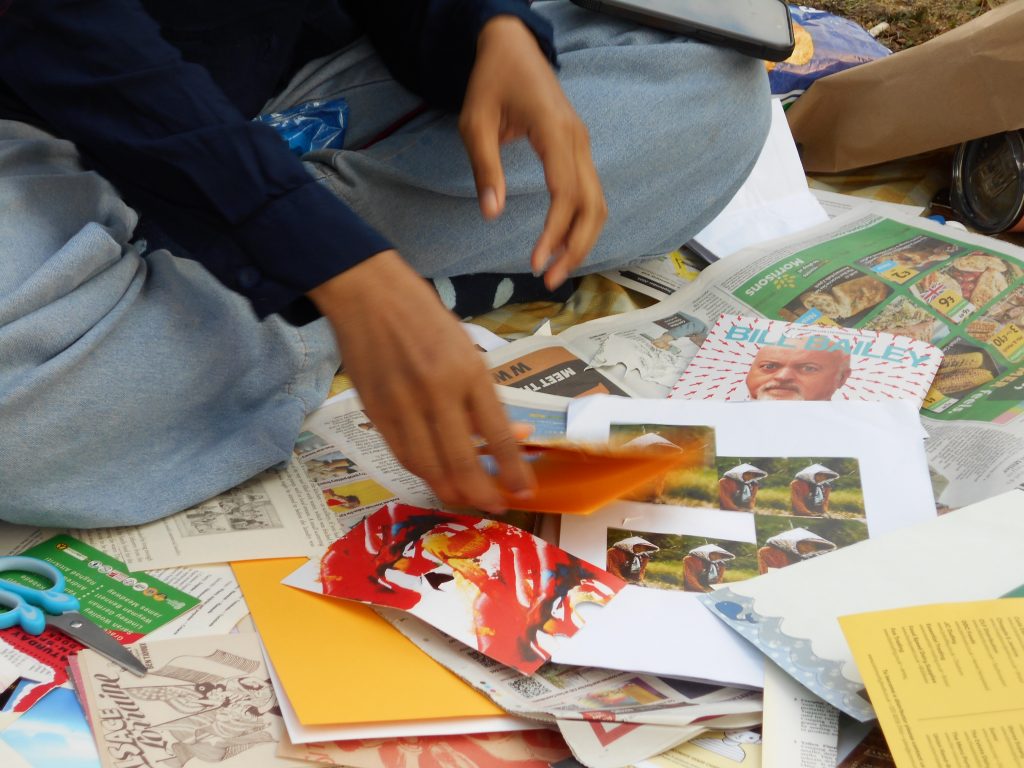
Welp.
The second intervention is DONE!
Although it was rough and made me got out of my comfort zone (initiating an event, gathering people around, SCARY). But apparently, I did??
But beforehand, why zine-making all of a sudden?
This is not all of a sudden, anyway.
Publication is one of the methods to communicate our ideas and thought, and zine is one of the possibilities of capturing creativity and human experience through a visual ethnography approach (Biagioli, Pässilä, and Owens, 2021).
Historically, zines operate at the intersection of art and activism, spanning the spectrum of social justice issues such as ecology, tenant’s rights, disability and political activism (Biagioli, Pässilä, and Owens, 2021). Oftentimes, zines are typically created with affordable, everyday materials and rely on simple, low-skill techniques like cutting, pasting, scribbling, and drawing, making zines highly accessible to made by anyone. Aligned with the values of sustainability, this session encourages participants to repurpose waste or scraps from their surroundings as the primary materials for their zines.
I adapted this method because I was inspired by Karasa BDG’s approach to prioritizing efficiency by utilizing minimal resources to maximize the utilization of available materials within their neighbourhood. And also when I attend a Pulp-Fiction workshop last month. These experience inspired me to use zine as a research method which also aims to challenge Indonesian willingness to take action on their waste materials into a new product or an art form like zine.
Within this research, zine-making is positioned as a participatory or co-design method, serving as a tangible medium for collective imagination to be articulated through the format of research publication.
How did the session plan out?
On my second intervention, I tested my method for facilitating complex conversations in the urban village, specifically about the future of our neighbourhood. I used the same strategy: discovering our memories about the neighbourhood through our five senses, analysing the STEEP priorities that urgently need to be addressed, and sharing our dreams and hopes. This time, I added an extra tangible activity for the reflection session: zine-making.
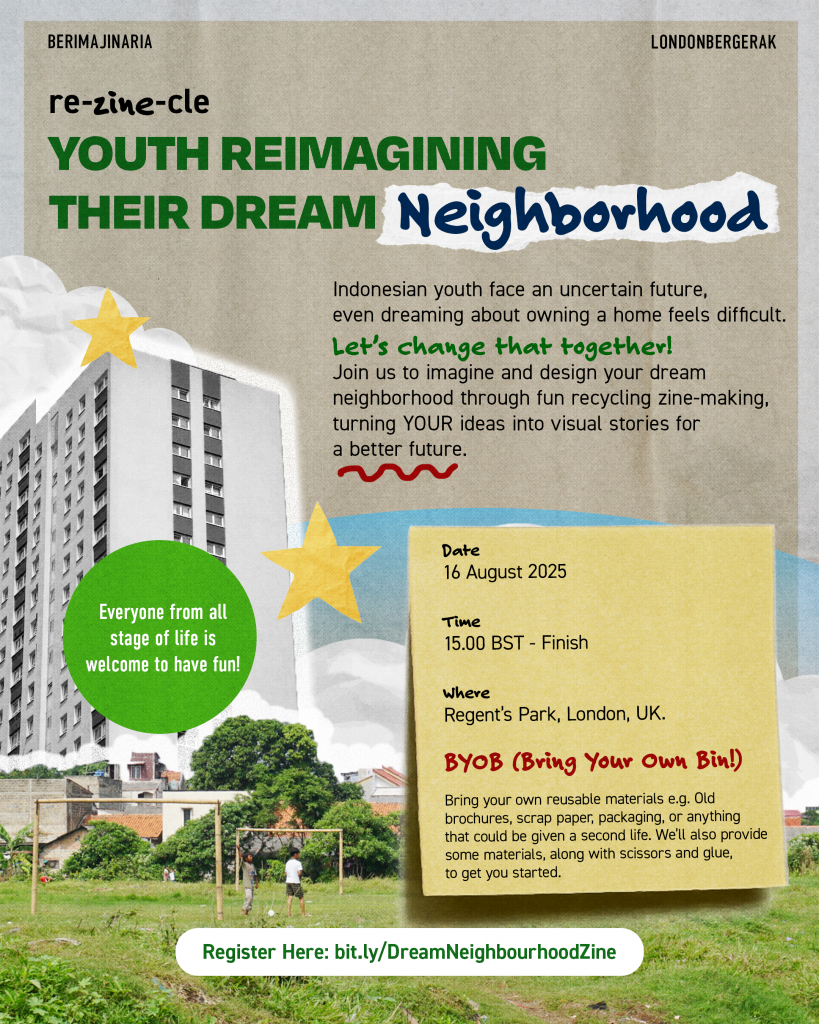
As mentioned on the image above, the zine-making event was held on August 16, 2025, at Regent’s Park in London. This activity was a collaborative effort between @LondonBergerak, an Indonesian activist group based in London, and my platform @berimajinaria, a collective movement (in the making) for building utopia through collective imagination.
I am utilising the magic of social media to create a hybrid platform that can engage both Indonesian communities online and offline. This inspiration came from an alumni’s night session, which I regrettably missed because I was away for 3DaysOfDesign in June 2025. (Thanks Meaghan for your help in gathering my feedbacks from the alumni, I love you tons!)

The purpose of the event was to invite Indonesian diaspora residing in London to attend and engage in a discussion about their future neighbourhood in Indonesia. I had sent out WhatsApp messages to every Indonesian in the UK’s WhatsApp groups, but only five people accepted and attended the zine-making event. Most of them were students pursuing their master’s degrees.
One of the reasons that I heard from my friends is because most of the students are currently on submission week or went out for summer trip, thus, not many people were coming to my session. Which is actually fine, because at the end we had a quality conversation and more in-depth knowledge exchange.
Although, most of them are my friends who I have known before :]. (Thank you guys, I owe you a lot!)
So, who are the participants?

Tadaa! These are the changemakers, artists, and students who have visions for the future of their homes. Among 6 registrants on the form, only 5 people showed up, and among five of them are two members of @LondonBergerak.
But these are the summary of their background:

Most of them fall under the age categories of 18 to 25 and 26 to 30 years old.

All of them are currently residing in London, UK.


They all lived (or currently living) in Indonesia, either in residential areas, urban kampung areas, or housing complexes.
The various background built some diversity in the perspectives on how to cultivate their neighbourhood. Making thinking throung design (in this context is zine) richer and unveil new possibilites.

On the initial discovery questions, I also asked what are the most valuable elements in a neighbourhood. And their top choices are including mobility, community, safety and security, affordable housing and flood free environment.
From these initial questions, I recognize that most of the youth are genuinely concerned about social and environmental factors, beyond economy, education, and politics when it comes to the factors that make up a neighbourhood. Reflecting to the first intervention with Cipadu citizens, they placed economic factor as equal as social factor.
In subsequence to this, the session in the park will justify this deduction from fragmented information and data gathered from the first intervention and zine-making form.
How was the session facilitated?
Before the session, I planned a step-by-step of the discussion in order to get a qualitative research from this session.

The planned was not like this before, I need to iterate from my previous framework in order to make more sense and create a seamless journey within 3 hours session. Thus, I adapted the exact questions I asked during my first intervention with Cipadu citizens.
Inspired by the power of ‘gotong royong’, this activity requires group discussion and collaboration, albeit the zine making are created by the participants themselves.
So here is how the process of zine-making session slash roundtable session was carried out:
- Discovery Session
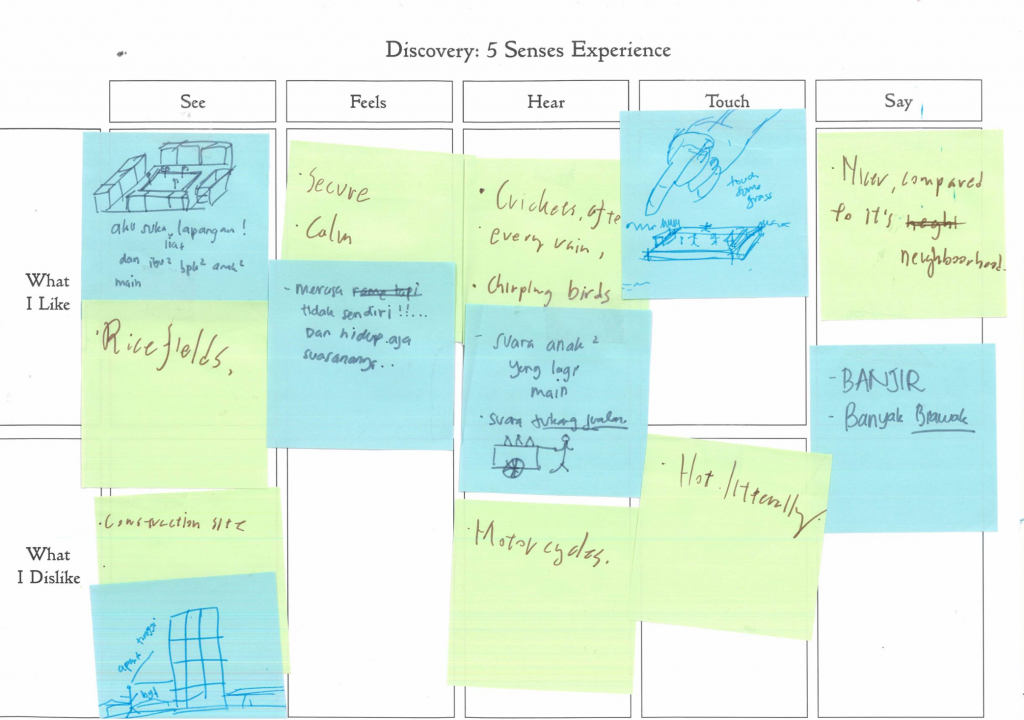

The discovery was divided into two pages because we printed the framework on A3 papers, necessitating the use of two pages for five participants.
From the “Five Senses” discovery, participants expressed a deep connection to nature, open fields, and communal life. These experiences evoke feelings of calmness, security, and connection, which are strengthened by the realization of the community’s presence, helping to combat feelings of loneliness. Participants enjoy the sounds of nature such as birds, children playing, and the presence of local traders that reinforce togetherness.
However, they are disturbed by urban pressures such as gentrification, vehicle noise, crime, insecurity, street thugs, mobility and environmental problems like flooding and lack of green space. A funny story about flooding, some people found flooding like a blessing when they were a child. This mindset expires as they grew older and realised that flooding is actually a disaster. Physical discomforts like heat and unsafe spaces also reduce their sense of belonging, this is an implication of climate change that currently happening.
Overall, the findings reveal a tension between the desire for a playful, green, and connected environment and the challenges of urban development, insecurity, crimes and ecological vulnerability.
2. Defining and Analysing Priority
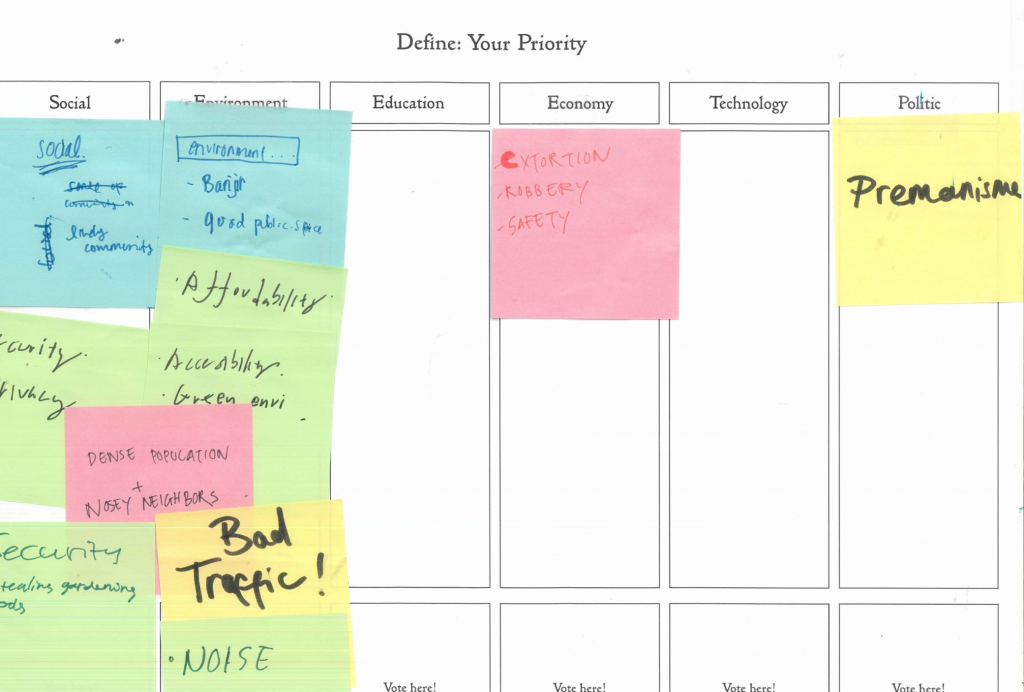
In defining priority, I used STEEP method again to categorise the experience gained from the five senses discovery.
It is true that many sticky notes were pasted and voted on in social and environmental categories. This demonstrates how participants consistently and persistently address these two issues since the beginning, which implying these are the priority factors that define their ideal neighbourhood.
In the social context, participants were particularly concerned about security and privacy. During the sharing session, they frequently mentioned issues of criminality and premanisme (street thuggery), such as robbery, extortion, or pungutan liar (illegal levies). This premanisme often arises from power struggles between indigenous residents and recent migrants to the area. Conflicts tend to occur because the indigenous group—the Batavianese—still feel entitled to the land that they had previously sold to migrants.
Fun fact, the Indonesian word preman originates from the Dutch term vrijman, meaning ‘free man’. During the Dutch East Indies period, this label was used for informal workers, such as non-contract overseers, and former convicts seized by the Dutch. Many of them later took on roles as informal security guards or vigilantes, often serving to protect colonial interests. And now, this preman becomes a new term for street gangster who identified themselves as the protector or the guardian of the area.

Source: Merdeka.com
Reflecting on the first intervention, the Cipadu citizen did not mention any issues with premanism. The context of safety and social security they are dreaming of is mostly on how the area is safe for children to play.
Audio experience also plays a huge sensory factor that makes the environment comfortable. “Noises” is being mentioned for three times on the board, implying that sounds build a quality environment.
The ZINES
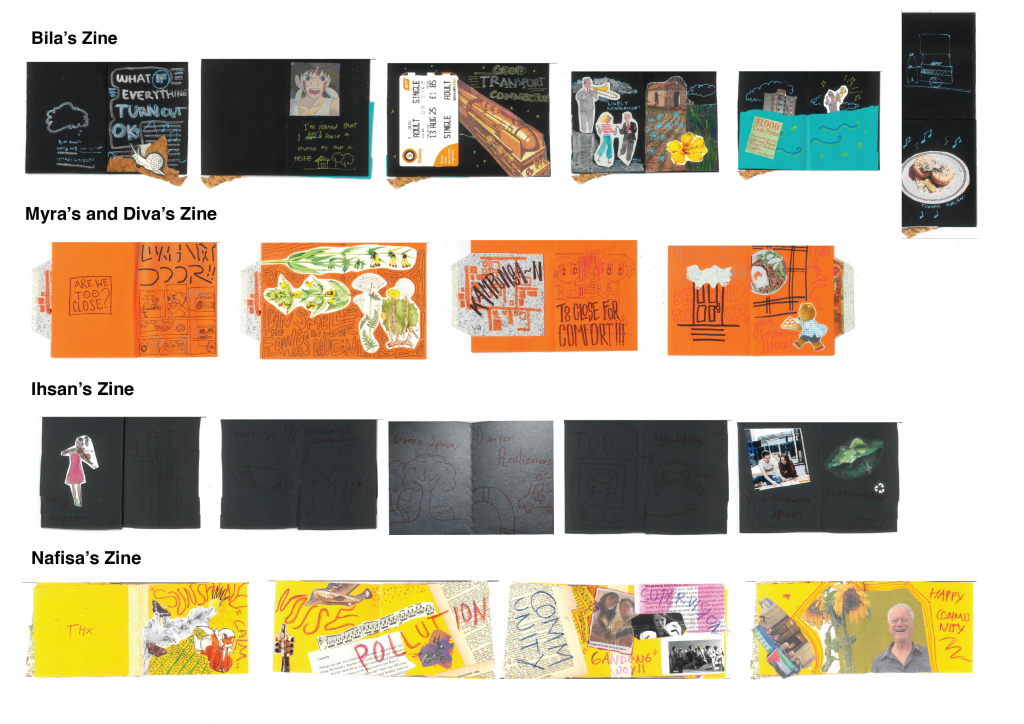
Here goes the zines from the participants slash the artists!
The question to answer on this zine-making is: “What are your ideas and thoughts about the future neighbourhood they want to a have?”.
During the zine-making session, I observed that people were putting in more effort in thinking about the ideas and content they wanted to include in the zines. I believe that the prompt or question that prompted the zine-making process should be clearer and more structured so that people feel more directed and know what to expect.
This laissez-faire zine-making format fostered a more creative and spontaneous output, allowing the collective imagination to manifest from the people’s aspirations. The themes expanded and evolved into a high-quality ethnography output from these zines.
Subsequently, these are some of the themes that emerged:
- Safety & Security: Bila (family, environment, mobility), Ihsan (night security, disaster resilience, affordability).
- Afforadability: Bila (owning a house)
- Density & Overcrowding: Myra & Diva (too close, sensory overload, privacy).
- Environment & Health: Nafisa (pollution, community warmth, nature), Ihsan (green space), Myra & Diva (Smells).
- Mobility & Access: Bila (transport connections).
- Community & Joy: Nafisa (happy community), Bila (togetherness).
We made some video presentation but I have not yet edit them yet, but surely going to upload them soon! But from the video presentations,
Connection with the first intervention
Later, I identified two major themes from the most keywords being mentioned througout the two interventions, with subthemes orbitting around them.

From these priorities, how to make these present challenges become the possible future.
The answer I can give right now, is “gotong royong” as the catalyst of bridging the present with possible futures.
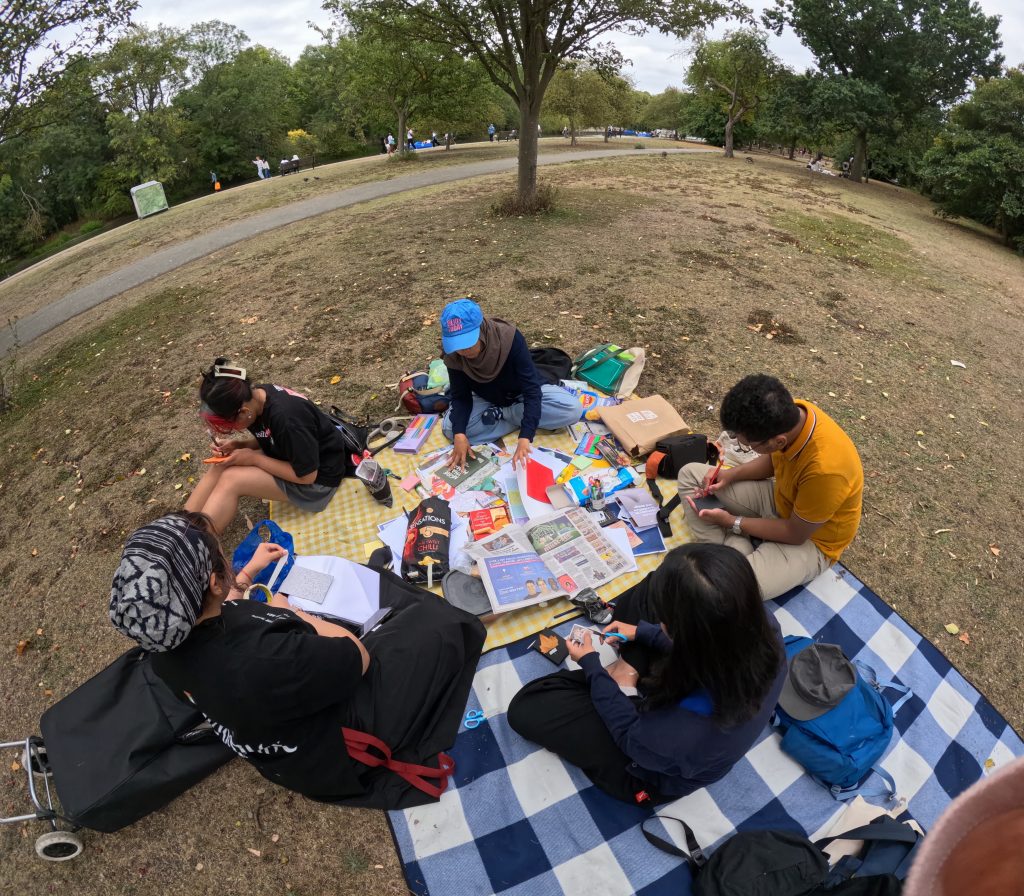
In the pressing situation, people often rely on improvisation and collective action (DelSesto, 2022). In Indonesia, we are coming together under the spirit of “sama rasa, sama rata” or a principle of equality and shared responsibility. This characteristic is deeply rooted in Indonesian culture through the practice of gotong royong, or mutual cooperation. Far from being merely transactional, gotong royong has historically been a crucial force in sustaining communities and even played a role in Indonesia’s struggle against colonial rule, as solidarity and collective resilience became sources of strength when external support was absent.
Bowen (1986) emphasize that gotong royong is not only a practical form of social organization but also a cultural ethos embedded in the Indonesian social fabric. It embodies the idea that when institutional or structural supports are lacking, people can still depend on one another—a value that continues to endure as part of Indonesia’s collective social DNA.
I experienced it myself during the process of making this research happened. I could not do this without mutual assistance I got from Indonesian back home and in the UK.
Therefore, what if Gotong Royong is not just a word or behaviour, but a design system that can be the engine for the hopes and dreams that made up our ecosystem?

Lastly, let’s close this long report with this beautiful sentence from Invisible Cities by Italo Calvino.

Bibliography
Biagioli, M., Pässilä, A. and Owens, A. (2021) ‘The zine method as a form of qualitative analysis’, in Adams, J. and Owens, A., Beyond Text: Learning through Arts-Based Research. Intellect. Available at: https://doi.org/10.1386/9781789383553_9.
Bowen, J.R. (1986) ‘On the Political Construction of Tradition: Gotong Royong in Indonesia’, The Journal of Asian Studies, 45(3), pp. 545–561. Available at: https://doi.org/10.2307/2056530.
DelSesto, M. (2022) Design and the social imagination. London ; New York: Bloomsbury Visual Arts (Designing in Dark Times).
https://www.merdeka.com/peristiwa/ini-20-titik-di-jakarta-barat-tempat-preman-biasa-ngumpul.html
Leave a Reply